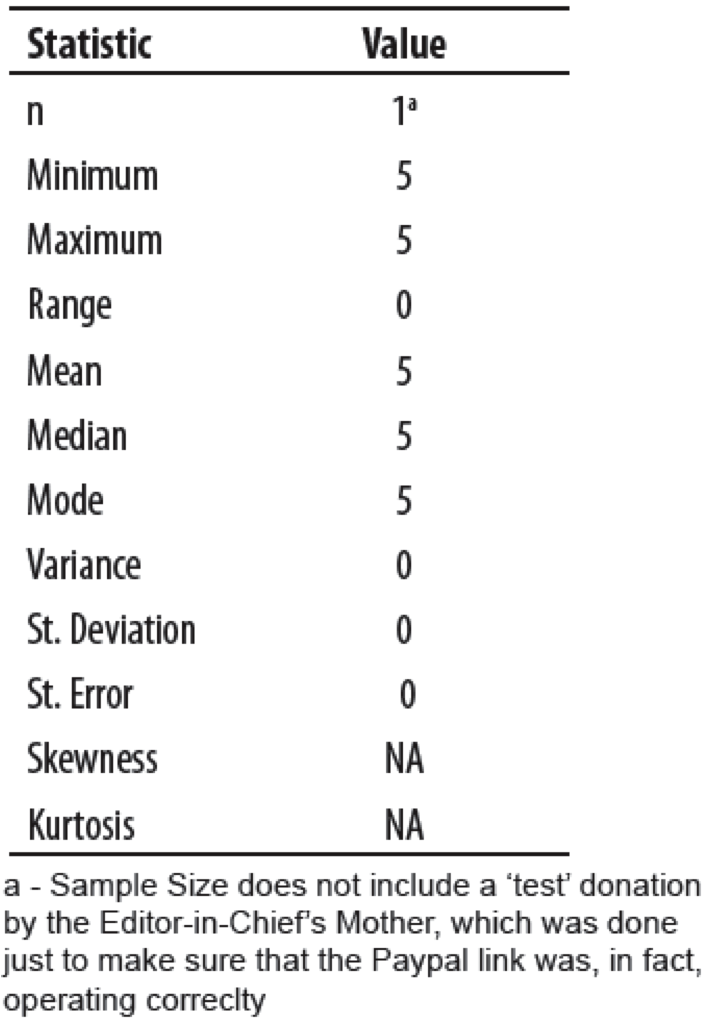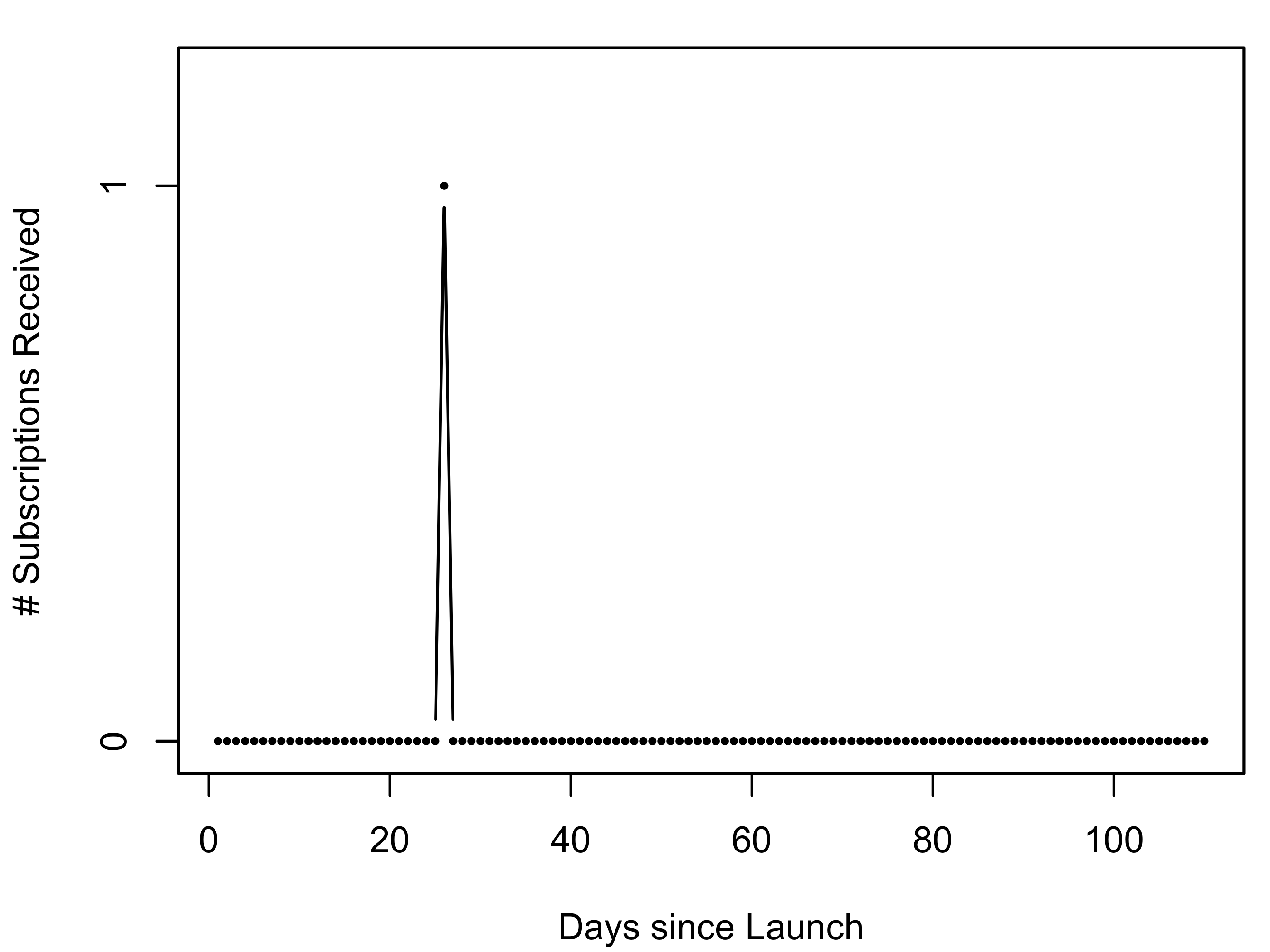
Tweet
January 7, 2015
Proceedings of the Natural Institute of Science | Volume 1 | Editorial 5
The many revolutions of the Proceedings of the Natural Institute of Science: A review and prospectus (but not a meta-analysis)
Matt J. Michel1
1 - Editor, PNIS

Introduction
It is a common tradition among academic publishers to begin a new volume every time the Earth completes one orbit around the Sun (or vice versa, for the geocentrists). As the current leader of all academic journals (based on Impact Factor) we will continue this tradition and shortly begin our second volume of the Proceedings of the Natural Institute of Science. But, first, we thought it would be appropriate to look back on Volume 1.
It’s hard to believe that we only launched about 4 months ago. Since then, our articles have been featured in NPR, Huffington Post, Vox, Entertainment Weekly, Onion's AV Club, and AOL. We’ve been referred to as “bored post-docs” (only half-right), “former NASA scientist[s]” (we’re not) and “The Proceedings of the National Institute of Science” (we’re all ‘natural’, thank you).
We believe that we’ve already made quite an impression on people’s expectations of a scientific journal. However, we’re a long way off from accomplishing those five revolutions that we outlined back in September. The rest of this paper will be an update on the progress of those revolutions and how we expect to continue our revolt in Volume 2.
Revolution #1: We’ve just expanded our number of journals!
Done! Moving on…
Well, to be fair, the intended consequences of our PNIS expansion did not exactly come to fruition. We had hoped that splitting into two subjournals (PNIS-HARD and PNIS-SOFD) would somehow arrest the seemingly exponential growth of academic journals. In reality, the number of new journals continued to rise. Some new titles include Arctic Science, Royal Society Open Science, and Journal of Vascular Surgery Cases. The Nature Publishing Group seems to be especially mocking us by releasing Cell Discovery, Nature Reviews Disease Primers, Frontiers in Cardiovascular Medicine, Microsystems and Nanoengineering, Frontiers in Robotics and AI, Nature Plants, as well as their ‘npj’ series which includes: npj Quantum Information, npj Microgravity, npj Systems Biology and Applications, npj Biofilms and Microbiomes, and npj Buzzword (projected).
The continual rise of journals in 2014 raises the question: How many more subjournals is PNIS going to have to launch? We hope that the answer is 100,000 because that is the number of new journals PNIS is planning on launching. To help us reach this goal, we have devised several strategies: 1) hijacking journals (e.g., Scionce, Biological Journal of the Linneam Society), 2) hijacking already hijacked journals (e.g., Epistemilogica, Journal of Nautilus Journal), and 3) personalized journals (PNIS-STEVE).
Revolution #2: Everyone can get in on the fun!
We believe that any person should have the opportunity to publish in an academic journal, regardless of their level of education or current affiliation. At PNIS, we have kept true to this policy. Our authors have spanned a wide range of educational backgrounds, from post-docs all the way up to Assistant Professor. It is our hope that this range will expand further in Volume 2 with the inclusion of graduate students (if they can take time away from their alcohol) to Associate Professors (ditto).
What about the educational demographics of our readers? Well, we simply don’t know, because we’re very proud to say that we do NOT collect any metadata on our readers/users. No, we leave that work for Google because we don’t know how to collect metadata and Google pays us fairly well for it.
Revolution #3: Peer Review: we’re not here to make friends!
For Volume 1, we experimented with a review process that could best be described as “random peer review”, which basically consisted of confusion on whether or not we had established guidelines for review (spoiler: we didn’t).
For Volume 2, we have carefully modified our review process to include these steps:
1. The Editor-in-Chief stands next to a chalkboard that lists the submissions to be reviewed.
2. One associate editor stands next to the Editor-in-Chief with a bucket of rocks.
3. Another associate editor reads the title of first submission from the chalkboard.
4. Immediately after the submission is read, the Editor-in-Chief takes a rock and throws it at a glass bottle that is placed exactly 60 feet 6 inches away. There are three possibilities:a. If the rock breaks the bottle, the paper is accepted
b. If the rock hits the bottle, but does not break it, the submission is to be revised by the author and sent back to PNIS.
c. If the rock misses the bottle, the paper is rejected.5. This process is repeated until all the titles are read.
Additionally, this whole process is to be done with a spread of carefully organized donuts and damn fine coffee.
Revolution #4: The Impact Factor is anything you want it to be!
In our first editorial, we explained that our Impact Factor was indeterminate, mainly because it is the policy of PNIS that none of our papers can be cited (see Michel 2014). Our editorial board decided to keep our Impact Factor at 54 for our first Volume, which made PNIS the scientific journal with not only the highest current Impact Factor but also the highest ever Impact Factor. Please note that it is extremely rare for new journals to achieve the highest ever Impact Factor in their first year of publication.
How do we project PNIS’ Impact Factor to change in 2015? Well, we could just wait until the new Impact Factor’s for all the other journals come out and just assign PNIS an IF that is 1 greater than the highest ranked journal. But then we wouldn’t be leading; we would just be following what every other journal is doing (but doing it 1 better). Instead, we feel that the time has come for PNIS to transcend the numerical constraints of the Impact Factor. So, for Volume 2, we are proud to announce that will be officially changing our Impact Factor from 54 to “Leadership”. Wow, how good is that going to look on your CV when potential employers see that you published in a journal whose IF is Leadership?
Revolution #5: Did I just hear somebody say “free PNIS”?
When we started this journal, we promised that PNIS would be entirely open access, meaning that it would be 100% free to read and share PNIS articles and 100% free to submit an article for publication. We are proud to say that we have honored that commitment[1]. Yes, we could act like other journals and charge $30 to view an intentionally blank page, or charge universities close to $1 million for a one-year subscription to our journals, but we didn’t know until just now that we could legally do that. However, despite these amazing success stories, we have decided to keep PNIS completely free for 2015.
How can we put forward such great content without charging any money? The answer lies in the great number of voluntary subscriptions that have been purchased by our dedicated fans. We called this program the “Panera Publishing Model” (PPM) because it was modeled after several Panera Bread restaurants in which customers were able to pay what they wanted (which included $0). Let’s take a look at how well the PPM operated for PNIS Fiscal Year 2014 (see Table 1 and Figure 1).


The good news is that PNIS broke our previous record for revenue! The bad news is that our previous record was $0 and that further research into the PPM revealed that even Panera seems to have abandoned most aspects of this pricing model. However, we are adamant about remaining a 100% open access publisher, and will just conveniently leave this link here.
One Eye to the Future: Volume 2
What can you expect from our upcoming Volume? For starters, we’ll probably do another article that analyzes a popular comic strip because those seem to be our most successful articles (our top 2 articles in terms of page views were this one and this one). The most cited scientific article of all time appears to be Lowry et al.’s “Protein measurement with the folin phenol reagent” published in 1951 (Van Noorden et al. 2014), so we’ll likely work on some article related to folin phenols (working title: “Which name for the Folin Phenol reagent is most popular: Folin-Ciocalteu reagent or Folin-Denis reagent?”). And, lastly, sex always sells, so stay tuned for our first ever article on sex (working title: “Effects of sexual intercourse on the efficacy of the Folin phenol reagent in the Doonesbury comics”).
We also would like to increase the number of submissions sent to PNIS. There are several reasons why you should submit an article including: 1) we currently have a 100% acceptance rate, 2) we don’t care how you format your references, 3) in fact, you don’t even have to include a references section, 4) you can totally swear!, 5) our pdf design is fucking awesome (see?), and 6) reviewer #3 doesn’t work for us. We know that you have some great satirical science ideas (remember, we’re selling your metadata), so all you need to do is work on those papers during faculty meetings or departmental seminars and send them in!
In closing, we would like to extend a very sincere thanks to everyone who has read, shared, subscribed, tweeted, liked, commented, pinned, stumbleuponed, digged, metafiltered, and redditted our Volume 1 articles. It means a lot to us when we see that we made someone smile, laugh, or snort/laugh, and it means even more when we’re able to do that while introducing some scientific concept that that person may have never heard of before. Thanks for making the Proceedings of the Natural Institute of Science possible and we hope to see you around for Volume 2!
Footnotes
[1] Lawyer’s Note: This commitment is non-binding [Return to main text]

Proceedings of the Natural Institute of Science (PNIS) by https://instsci.org/ is licensed under a Creative Commons Attribution-ShareAlike 4.0 International License.